7.2 /10 1 Votes
6/10 Steam Distributor(s) Google Play Initial release date 4 June 2015 | 4.2/5 Google Play Composer(s) Mitsuto Suzuki | |||||||||||||||||||||||||||||||||
 | ||||||||||||||||||||||||||||||||||
Artist(s) Toshiyuki ItahanaToshitaka MatsudaShintaro Takai Developers Square Enix Holdings, Square Enix Co., Ltd. Similar Final Fantasy games, Square Enix Holdings games, Role-playing games | ||||||||||||||||||||||||||||||||||
Mobius final fantasy announcement trailer
Mobius Final Fantasy (Japanese: メビウスファイナルファンタジー, Hepburn: Mebiusu Fainaru Fantajī) is an episodic role-playing video game developed and published by Square Enix for iOS, Android, and Microsoft Windows. It was released in Japan in June 2015, and released internationally in August 2016. The player controls Warrior of Light (Wol), a man who wakes with amnesia in the world of Palamecia, and must help conquer the dark forces attacking its people. The game features gameplay elements from previous Final Fantasy titles, including leveling, exploration via standard navigation and fast-travel systems, and turn-based combat tied to a job system. Common themes were also drawn from the original Final Fantasy title, such as "warriors of light" and their fight against chaos and darkness.
Contents
- Mobius final fantasy announcement trailer
- Mobius final fantasy gameplay first look mmos com
- Gameplay
- Plot
- Development
- Music
- Release
- Reception
- References
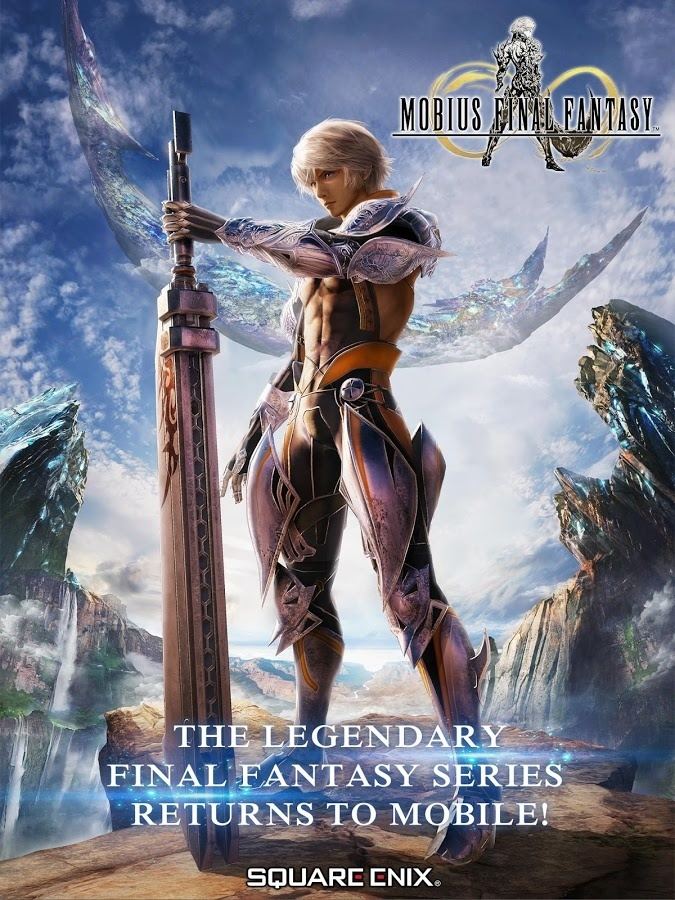
The game, which began development in 2013, was developed around the concept of a mobile game on a similar level to a home console game: this goal prompted skepticism from both in-house staff and external sources. While some assets were outsourced, most of the development was done by Square Enix. Multiple staff from previous Final Fantasy titles were involved in development, including producer Yoshinori Kitase; writer Kazushige Nojima; character designer Toshiyuki Itahana, art director Toshitaka Matsuda, VFX director Shintaro Takai, environment director Takako Miyake; and composer Mitsuto Suzuki.
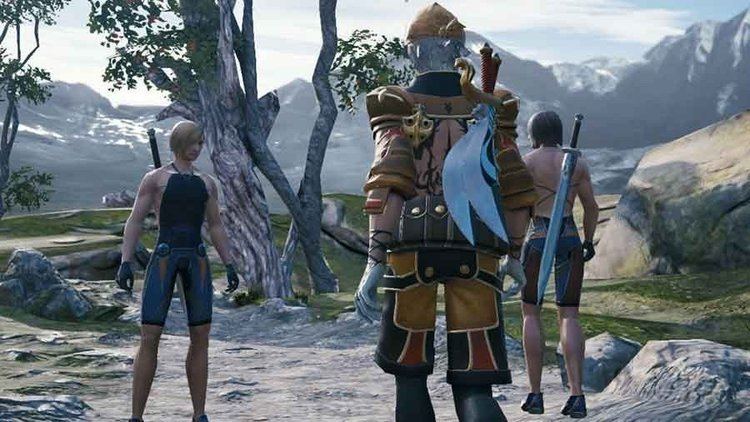
The game registered over two million players within the first few weeks of release. Square Enix cited Mobius Final Fantasy as one of the most successful mobile titles they released in 2015, having over three million downloads in Japan before the end of the year. The English version also reached one million downloads within a week, with over three million in under a month. The graphics and gameplay were praised by reviewers, although some called the overall combat experience "simple". The game also received several awards and accolades. It reached over 8.8 million downloads worldwide in November 2016 and was awarded for being the most beautiful game on the Google Play Store in 19 countries for 2016. Mobius surpassed 10 million downloads in January 2017.

Mobius final fantasy gameplay first look mmos com
Gameplay
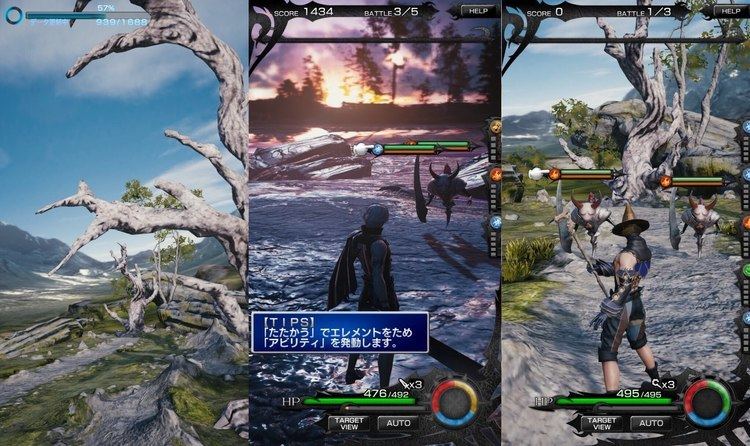
Mobius Final Fantasy is a role-playing game designed for mobile phones. The player controls the game's protagonist Warrior of Light (Wol) while navigating Palamecia. Players can customize settings, graphical quality, and adjust controls for their dominant hand. During local navigation on the field map, the player taps a location on a map and the character travels to that location. In some self-contained areas, the player can directly control the character. Along with standard navigation, the player can navigate the game world using a fast-travel system, progressively unlocked as the player progresses through the story. Many of the features in the game, such as the leveling system and exploration, are similar to those from previous home console Final Fantasy games.
Mobius features a tactics-focused, turn-based battle system, with players able to activate attacks by tapping enemies on screen. Players can use standard melee attacks with close-range weapons such as swords, and magical attacks. During combat the player accumulates Elements, which are necessary to activate Abilities, the game's form of summoned monsters. When ready for activation, a tile appears on-screen that the player touches to activate the Ability. Abilities have different attributes: the Shiva Ability unleashes an ice attack, while the Fat Chocobo Ability raises defense for eight turns while automatically healing the player. Elements can also be used by the player to strengthen their resistance to elemental attacks. If an enemy's weakness is struck enough times, their "break gauge" meter will be drained and they will be left weakened, allowing the player to attack freely. A job system and character abilities related to them form a key part of the system.

The player starts off with the Onion Knight job. Each job can be leveled up using special "seed" items collected in battle to fill in a skill panel. Once the panel is complete, the job will evolve, such as the Onion Knight evolving into the pure Warrior class. As jobs change or evolve, the character's appearance will be altered to a degree. In the Chapter Two content update, Samurai, Assassin, and Red Mage jobs were added. In February 2016, multiplayer functionality was added, enabling up to four players to take on bosses.
Plot
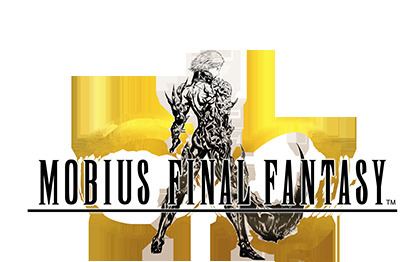
Wol, the main protagonist, awakes stricken with amnesia in the foreign world of Palamecia. He is one of multiple "Blanks", people brought to Palamecia from other worlds and suffering from amnesia. Palamecia is under attack from the armies of "Chaos", and Wol must fulfill a prophecy in Palamecia that one of the Blanks is a "Warrior of Light" who will free the world from its darkness. Wol is aided on his journey by Princess Sarah Lotte Cornelia, the princess of a kingdom of Palamecia, and Mog, a moogle who volunteers to help in Wol's quest.
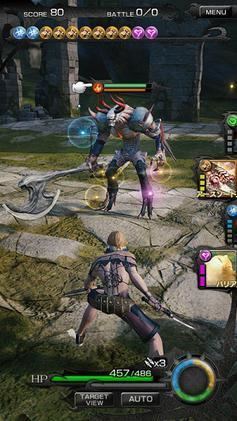
Chapter 2, entitled "Prediction and Hope", includes Wol and Mog adventuring through the Ishtar desert and Rune Temple. A side quest was also included, entitled "El Dorado of the Oblivion", which is set in the ruins of "Gold Volost of El Dorado". In chapter 3, Wol is traveling to see Princess Sarah, who is waiting at her castle when she is attacked and held captive by the armies of chaos. Wol is then tasked with saving the princess and fighting against the overwhelming power of the Chaos giants.
In the chapter 4 prologue, Wol and Sarah begin an adventure to find the "Rune of Earth" to keep it out of the hands of chaos, and later in chapter 4 the story continues through new lands. In chapter 5, Wol journeys to find the source of the light that may give him the strength to conquer chaos. The sixth chapter will shift focus onto a different character, the heretic sorceress Meia.
Development
The concept behind Mobius was for a mobile experience comparable with console games. Though it was possible to make a smartphone game equivalent to console games, it had yet to be done, so game producer Yoshinori Kitase sought to fill this perceived gap in the market. It was called the first Final Fantasy mobile game of this scale. While creation of some artwork and graphics was outsourced, most of the concept work and development was done in-house by Square Enix. Instead of a new development team dedicated to mobiles, the production team was largely made up of veterans from the console Final Fantasy titles. The staff included scenario writer Kazushige Nojima and producer Yoshinori Kitase. The story is connected to the original Final Fantasy only thematically through its focus on "warriors of light" fighting against chaos and darkness: it is not a remake or directly related to the plot of the original. It is also considered by the team behind the game as a full entry in the series rather than a spin-off. Speaking after the game's initial release, Nojima stated that he felt his scenario was too bulky for a mobile experience.
Development began in 2013, and prompted skepticism from both Square Enix staff and its prospective platform managers, who were more used to the dominant 2D-based mobile games. One of the problems cited by project leader Naoki Hamaguchi was creating realistic facial expressions equivalent to those used in the 2013 film Frozen. For development, the team used the Unity game engine. After Unity Technologies updated the engine in 2015 to the Unity 5 version, the game was also updated to run on the improved software. The team needed to take differences between different phone models into account to allow high performance. To help with development and overcome potential difficulties handling the Unity engine, a special development environment and structure was created. The team used physically based rendering to create realistic lighting and environmental effects. The budget was far lower than graphically equivalent console titles, so the team were reluctant to buy in helping tools and had restrictions on staff numbers: one person was working on all the game's backgrounds, while three were in charge of character designs. Using experience from the development of Final Fantasy XIII, the team were able to create high-end graphics within mobile restrictions.
The characters were designed by Toshiyuki Itahana. In common with his typical drawing style for characters, Itahana created Wol to be a heroic fantasy character that both fitted within and did not conform to earlier Final Fantasy titles. He and other designers created the multiple job outfits to further convey the fantasy setting. After its reveal, some changes were made to the character's initial costume: due to negative player feedback about the amount of skin shown, the Onion Swordsman outfit was adjusted to be more covering. The game's environments were designed by Takako Miyake, who had previously worked on console Final Fantasy titles. She did not change her working style for Mobius Final Fantasy: all the assets were designed in high definition, and only adjusted slightly when they were brought into the mobile environment. The visual effects were handled by company veteran Shintaro Takai, whose main preoccupation was to make sure the game did not slow down during the flashier visual combat effects due to hardware constraints. The cutscenes were not affected by these issues.
Music
The music for Mobius Final Fantasy was composed by Mitsuto Suzuki, whose previous work includes The 3rd Birthday, Final Fantasy XIII-2 and Lightning Returns: Final Fantasy XIII. When he was first asked to compose for the title, his impression was of a whole new setting that retained nostalgic elements from earlier games in the series, which he sought to incorporate into the score: a piece that encompassed this was his reorchestration of "Prelude". As part of writing for the game, he needed to create new tracks for game updates, which put added pressure on him to create music that would appeal to players. A concept present from an early stage was changing the battle music depending on what job was equipped by the player: Suzuki created an initial battle theme that acted as a base for other themes, then added elements like electronic elements and vocal work to give derivative tracks variety. The majority of the game's choral work, such as with the game's main theme, was done using synthesizers. Suzuki also needed to do remixes of earlier Final Fantasy music, such as the "Chocobo" theme, and pieces from other Final Fantasy games that would appear in special in-game events. Suzuki estimated that he created between 40-50 songs for the game. The music was recorded at the Red Bull Studios in Tokyo.
An official 2-CD soundtrack album for the game, Mobius Final Fantasy Original Soundtrack, was released through Square Enix's music label on February 26, 2015 under the catalog number SQEX-10534-5. The music on the album covers Chapters 1 to 3. According to Suzuki, this was due to the music feeling like it had reached a natural transition point by that stage of the game.
Release
A trademark for its original title, "Mevius Final Fantasy", was filed by Square Enix in October 2014. The game was officially announced in Famitsu two months later under the same name. Two days later, a teaser site was opened in both English and Japanese with a message from Kitase about the team's vision for the game. Its final name was announced during a livestream by the company dedicated to the game. Both titles, along with the logo artwork, took inspiration from the concept of the Möbius strip. Because of its origin, the title was changed from Mevius to Mobius. It was also apparently done in preparation for an international release. Pre-registration for Mobius opened on April 27, 2015, with a special weapon and item available to those who registered. In late 2015, no localization had been officially announced, though Kitase revealed through the dedicated Final Fantasy mobile app that it was under consideration. In a later post on the app during first anniversary celebrations for the game, Kitase confirmed that a localized version was in development. The global version was released on August 3, 2016.
Reception
During its pre-registration period, the game received 200,000 registered users. By July 12, just over a week after release, the game had one million registered players in Japan. This number had expanded to over two million by the following month. Speaking after release, Kitase said that Square Enix considered the game a success as it introduced the mobile community to AAA-style graphics. In Square Enix's 2015 annual report, Mobius was noted as one of their successful mobile titles for the year, stating that the higher production values when compared to other mobile games on the market had contributed to its popularity. In addition, Mobius was among the finalists for the 2015 Unity Awards for mobile games in the "Best 3D Visual Experience" category, and was named among Japan's "iTune's Best of 2015" by Apple Inc..
Dengeki Mobile, in a pre-release review, praised the gameplay and strategy present in early random encounters and boss battles, although the reviewer had minor reservations about the quality of the entire game as they were not able to play through all of it. They also stated that players might encounter difficulties during some boss battles. The reviewer summed up the experience as "simple, yet engaging". Famitsu, in a similar feature, praised the gameplay and presentation, echoing many of Dengeki's compliments. One thing they noted was that the performance needed to be adjusted for different mobiles as running the game rapidly drained the phones batteries when on its highest settings. The reviewer also recommended tablets over mobile phones as a means of playing the game. Western reviews were similarly mixed, with Touch Arcade praising the games visuals but calling the user interface an "overly busy nightmare". Kotaku examined the game in July 2015 and called the gameplay "monotonous" and lacking in plot, though it noted that many chapters were still to be released.
For the Western release of Mobius, the pre-registration exceeded 125,000 registered users.
It was awarded for being the most beautiful game on the Google Play Store in 19 countries for 2016. Mobius surpassed 10 million downloads worldwide in January 2017.
